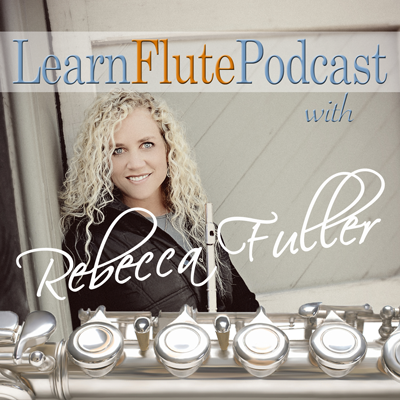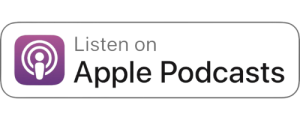Learn Flute Podcast SHOW NOTES:
In this episode, we discuss what to learn after the flute basics.
Learn Flute Podcast 123
Press the Play Button to Listen Now:
Podcast Transcript
So, you think you have many of the main skills learned and are starting to make some real music.. Well, how do you know what to learn after the flute basics? Let’s discover this fun question now – whoop whoop!
Well hello hello! I’m Rebecca Fuller, your instructor and expert on all things flutey flute a toot toot toot.
Fancy meeting you here again today. It’s so much fun to take a step aside, let our flute rest for a minute, and just soak in some new thoughts or inspiration.
I welcome you to this Learn Flute Podcast where we’re going to do a little discovery work that could be quite key, and help you continue in the right direction of great music making here at Learn Flute Online.
Many of you who are listening right now are already members of our Learn Flute Online (LFO) community, so good job for being here. We always have a lot of fun.
And for those of you who are listening right now, who are NOT official members – well, we’re also glad you’re here, and we invite you to learn and up your level of excitement for this instrument flute by joining in our community as a level member inside the Learn Flute Online website.
Well, we have a big Gold Level where all the foundations are learned, practiced, and enjoyed, and also we have very large Intermediate and Advanced Level to keep you on the path and advancing consistently.
You’re going to love it!
Since this season is winding down soon, I thought we could take this time to start getting ourselves back into a good schedule for the upcoming months. I, like many of you, had a vacation or two over the past few weeks, and now it’s time, like I said, to get back into a good schedule.
I went hiking, and fishing, and I spent time enjoying my family. We have a lot of new things coming to our family soon, and I want to be sure I’m all organized and ready. Big things are happening. And it’s possible you have a similar schedule.
Now let’s talk about some of these things today. You know, it’s really normal for people to get into playing an instrument and think that it’s all about learning the notes. Now, don’t get me wrong, because the notes are a major backbone to playing melodies, songs, and the tunes we love. What we need to realize though is that this is just a tiny sliver of what’s to come, understand, and enjoy in music.
On the flute, we have some special skills to learn about that makes us unique in our learning style. This is why you’re here. I will guide you through imperative flutie things like articulation, intonation, resonance, and fluency. Whoa.. well that sounded kind of like a fancy list.
No worries, I’ve got your back.
When you’re a brand new beginner there are some really important skills to get a grasp on. Now, that was actually a pun intended because the grasp or the hold on the flute is one of the most tricky things at first… and we don’t actually ‘grasp’, grab, or grip our flute even though it seems pretty slippery for a little while.
We actually have some balance points to learn about and as we gain more confidence and practice these, make little adjustments, then we are able to move into a new thought.
Let me give you some specifics on this. Picture this: your flute comes in contact with your body in a few different places. Basically two general areas. Your hands and your face.
So yes, balance point number one is our left hand just under our first finger, on top of our palm bone. I call this the comfy couch. This is really the only part of the flute that is being held up, even though it’s on a slight angle.
And the next point of contact is our right hand thumb, and then I like to include our right hand pinky as well because without it on, we’d have a heck of a time keeping our flute under control – especially in the first weeks and months. And you’ll learn where is appropriate to have your pinky on and off as we move along.
Now our face is the last main spot our flute touches that I want to mention, and then we’re going to go backwards for a second to what we just talked about.
Our lip plate touches our chin as it rests under our lower lip. I could write a short little book about how we can focus on this area of our face in order to improve our tone and our flute life, but I wanted to, for the purpose of this podcast, to go back a step, like I said, and give you an example of different levels of skill progression so that the question of “what to learn after the flute basics” is understood easily and brought to light.
So, remember a minute ago when I mentioned that our right hand thumb touches our flute as one of our balance points?
Yep – it does, and when we’re brand new, many people feel like they’re supposed to use this thumb to literally hold the entire instrument up. Interesting thing to note here is that this is just kind of a perception that is not going to be true after you learn some things and gain a little bit of finess with these balance points.
The right hand thumb is actually one of the pivotal parts of hand position and balance that causes what I would call a chain reaction within the entire flute playing ‘eco-system’ if you will.
Here’s a little list of different types of thumb positions that I see – now, let me preface this with the notion that I’m not saying that these are right, correct, but that I do see them often as I teach and it’s a point of correction and gentle repositioning at lessons for a few weeks, months, or even years for flute students. So listen up.
The first being what I would call the pointed towards the head thumb.
The second would be the turned under holding all the weight thumb.
The third is the coming straight up from the depths of the sea thumb.
Haha I wish you could see me right now demonstrating as I say these.
The fourth is the bendy thumb – basically bent in a complete U shape.. Not sure where to place it on the barrel of the flute.
There’s also the long fingernails hold it up from the knuckle thumb.
..and there’s also the perfect position behind the barrel on the top corner of the thumb, thumb.
Well I could probably come up with a couple more, but you get the idea. People get all sorts of creative when learning how to hold the flute.. And then these initial techniques become habits.
And, it’s not like there is any fault before you’ve learned, but once you have, and you know the what’s, how’s and why’s… things really do fall into place so much better.
First of all, once your thumb is in the right position and all comfy and relaxed, then your other four fingers can fall into place.
This erases pounds and pounds of tension in the hand and frees up the muscles to just relax so that your fingers can move very quickly on their own without stiffness and stress.
Imagine this: Try to run from one side of a room to the other in a hurry with some of those exercise stretchy-bands coming out of the wall and tied to your legs. I mean, okay. You could do it right… it just would be way harder than it needed to be.
This is what it’s like when your hand position is, I would say, ‘off’. It’s like trying to move your fingers really fast with stretchy bands tied to each one of them. It’s just way harder than it needs to be.. Which makes playing speedy passages and tunes kind of on the impossible scale until this is under control.
So, okay. Why did I bring all of this up?
Well, alright let’s go back to our subject for this episode, which is all about what to learn after the flute basics.
Some people think that just getting to the point where you know a few notes and can hold the flute and blow a couple of octaves is considered the basics.. But I’m here to tell you that I’ve been playing the flute for many many moons, and I feel the basics are something I revisit every single time I play.
So how can I improve my “basic skills”?
If this is a question you now have right now because I’ve brought it up here, then you, my friend, are on the right path already.
Some people skip over the important techniques- and their live music will always be lacking because the stretchy bands are still on there.. Just pulling back.
Okay so, what can we do to improve?
Ahhhh I am so excited you asked!In the Levels and the program here at Learn Flute Online I have set up the lessons in a progressive order that I call the “spiral of improvement”. Those who are in the members area have had this explained to them and demonstrated and shown, in the first days upon joining.
Basically, this is a walk through demonstration of me showing that we’re going to take our skills, techniques, and basics on the level we start on.. Which is a great level by the way. We are where we are, and we’re never to be ashamed of this.
We musicians have learned to keep our heads high and keep walking the walk because it’s the only way to get to where we’re going.. And the cool thing is that the journey to get there is the best part! Besides the friends we meet, we also are doused and drenched, completely bathed in aural creativity every time we listen or learn.
So we just keep taking our skills where we are, we use them and improving them.
In the lessons here, like I mentioned we go in kind of a spiral pattern.. And this is why sometimes you’ll be able to cruise right along for a few weeks until you hit a point where something just isn’t clicking like the previous pieces were – and this is when you know you have some special techniques to learn and/or improve on.
Then like a predictable clock, things will start ticking and you’ll be on your way again.
I will show you all of them.
There’s a perfect list.
I’ll take you through what you need in order to to play the way you want with expression, beauty, power, and emotion.
Sometimes we forget this mighty lesson and we get all in our heads that becoming a solid musician is all about playing longer and longer songs. I distinctly remember a long time ago, a 6th grade girl bragging to someone on the playground that she was playing 7 page songs – therefore she was really good.
Well, I heard her at the talent show, and I was a bit sad that she had been misled. I don’t say this to discredit her, but I worried this would be her mind-set for her entire learning life.
Haha, in the cosmetic world we always say that long hair is beautiful.. But not if it’s 13 inches of split-ends. Some of you will understand this and can apply it to your musical efforts.
Let’s embrace our basics and continue to spiral through the levels as we review, re-use, and re-new our efforts to become better each time we play.
Not sure what to do?
Oh – I love this question.
I’ll help you.
I absolutely love working with self-learning adults and smart youngsters because unlike paying a private teacher to babysit your every move, you’re thinking. You know, you have your noggin turned on and you’re doing this.
And this is WHY Learn Flute Online is so exciting and the best place on the planet to learn to play the flute.
We take a shortcut by doing this. By helping you learn to think and learn yourself, instead have having to have somebody hover, and babysit every manuver. You can do this.
We have the best community of like-minded people who are just jumping up to improve themselves all the time. And what energy it is!
I congratulate you all!
So let’s quickly go back through our list I mentioned at the first of this episode so we can remember some of the different areas of what to learn after the flute basics.. They are: Imperative flutie things like articulation, intonation, resonance, and fluency.
So articulation is all about how we annunciate our phrases and melodies within. Here’s a quick speaking example:
What if I said:
The quick fox jumps over the lazy dog.
Would you know what it was?
The quick fox jumps over the lazy dog.
Now what I did was I basically forgot about my tongue as I spoke. This is a good demonstration on annunciation. Now if I did annunciate, and I used my tongue and the parts of my mouth appropriately, I would use those same words to sound like this:
The quick fox jumps over the lazy dog.
Now if I were a beginner speaker or a beginner reader, I might sound like this, slow and pronounced really carefully.. Kind of like a first grader:
The quick fox jumps over the lazy dog.
You’ve all been here before, right? Yah, me too! But guess what? We didn’t stay there for too long now, did we? No we didn’t.
We worked on articulating and separating each syllable correctly and then blending things properly and suddenly.. Voila! The quick fox jumps over the lazy dog.
Then,.. We get fancy and learn to add appropriate expressions in here – and tadahhh even more ways to talk about the quick fox jumping over the lazy dog.
It’s like story telling. But instead of using words, in music we’re using a variety of pitches, rhythm patterns, and special articulation recipes that create beautiful phrases that capture the attention, minds, and hearts of our listeners. Even if it’s just ourselves who are hearing it – it’s very satisfying.
I know it and you know it! We need to learn to articulate the flute way.
Whoo hooo! What a great day to be alive. Thank you for being here. I just get all fired up and full of happiness when we talk about ways to improve ourselves .. and especially our music and mind-set.
I’ve always felt this podcast has a super special place, and it’s very special for our learning program.
It’s not just our fingers that are doing all the work here.
Our mental attitude is the other half to making and keeping this life-long sport.
Well thanks again for being here today – you guys are pretty much the best. I feel good knowing that you’re progressing and enjoying the program here.
Continue on, because you are .. awesome!
I’ll play you out again today for some inspiration and fun demonstration on what you can do on a flute… or three- three flute. And if you’re not a member of Learn Flute Online yet.. Head on over to the website and click the get started now button so you can watch for a special invitation from me so that we can continue the conversation flowing and going here.
What to learn after the flute basics?… uh.. Let me show you! Okay, thanks for being here. We’ll see you next time.
Thank you for Tuning In!
Please consider subscribing and taking a minute to leave a review and rating for the podcast on iTunes.
I hope you’ve enjoyed learning about what to learn after the flute basics. Tune in for the next episode.









I’ve been following the podcast for about a year now. It’s just another way I feel Rebecca motivates her students. Today I discovered how important articulation can be. Being a grandmother of a 6 year old brought laughter to some of her images. Lately it has been “me read, Grammy”.
Articulation on the flute helps with the story the music is telling. Maybe this is the correct tonguing but the body position also tells the listener something. If you’re excited about the song you are playing, your posture and the way you hold the flute adds to the performance.
Thanks for reminding us of how far we’ve come and adding to the excitement to getting”Back to School” and into our fluting classroom. See you online!
Judy,
I’m so glad that you have been enjoying these podcasts maybe as much as I enjoy making them ;). That 6 year old sounds ADORABLE! Thanks for sharing that little tidbit of your life with us today. I hope you’ll keep listening, I have many more podcasts to come- for you! I know you’ll love them. Happy back to school time, we’ll see you in the modules!
Rebecca
Hi Judy, I’m going to have to get this Grammy book! Love it and the imagery is perfect. You understand well, and I am so happy you are a regular listener. Keep it up! 🙂 Rebecca